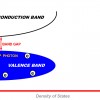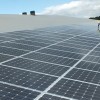Valence Electrons and the Band Gap
In semiconductor atoms, electrons are confined to a number of bands of energy and forbidden from other regions. The term "Band Gap" refers to the energy difference between the top of the Valence Band and the bottom of the Conduction Band.
For the non-scientist, one way of thinking about the PV Effect is to imagine two very tall tower blocks a short distance apart. Electrons orbit around the perimeter of the Valance Tower roof – there are no stairs or external fire escape to conduct the electrons away from the roof, they are effectively stuck there. They also don’t have enough energy to jump over the Band Gap onto the roof of the nearby Conduction Tower.
The Electrons need some additional energy to provide the necessary impetus and this comes in the form of light particles called Photons. When excited by a Photon of the ideal wavelength a Valence Electron is empowered to jump the Band Gap onto the Conduction Tower roof.
Now think of a city covered in nothing but Valence and neighbouring Conduction Towers. During daylight hours Photon excited Valence electrons jump to the nearest Conduction Tower. However, we don’t know and cannot predict when and where the process will happen – it is chaotic – and the Conduction Towers have no links, so the liberated Valence Electrons cannot flow in a single direction as electrical current. That was the crucial challenge facing the world of science following Becquerel’s observations of the PV Effect in 1838.

















